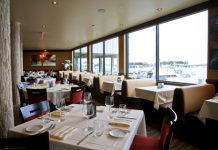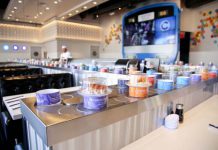
“Let’s Eat!”
That’s the theme of this year’s Orange County Fair, but at the Fair’s popular Wine Pavilion, a more appropriate phrase might be “Let’s Taste.”
Every year, fairgoers have the opportunity to belly up to the tasting bar and sample wines ($1.50 per one ounce taste) that won medals at the OC Fair’s renowned wine competition, now in its 35th year. The wines run the gamut from familiar labels to newcomers, but all are judged equally in this challenging battle of the grapes.
We never miss the opportunity to try the wines at the OC Fair, and always eagerly hope to discover our next favorite vino. We’ve also been curious to know what goes on behind the scenes of the competition, so Jerry Hirstein, president of the Orange County Wine Society (the organization that conducts the judging), agreed to let us take a peek at the judging process.

The OC Wine Society holds its judging in early June at the Hilton Hotel in Costa Mesa. Nearly 100 notable names in the wine industry – mainly winery owners and wine makers from throughout California – agree to participate as judges. These judges taste a total of 2,500 wines over the course of a weekend (a far cry from the first competition, which boasted four entries and one medal).
“Each winery submits six bottles for the competition,” explained Hirstein as he led us on a tour of the competition’s temporary facilities housed in several of the hotel’s ballrooms and meeting rooms. “We use two bottles for judging. One is the primary bottle, the second is what we call the B bottle. If the judges think the first bottle is spoiled, we go get the B wine.”
“The judging is called a double blind,” adds Hirstein. “The bottles have a bag over them with just a computer code, so nobody knows what is in the bag other than the varietal. They are poured in sequence based on sugar level and price point. The judges fill out score sheets, and their votes are tallied and then converted into gold, silver and bronze medals.”
We learned that each judge tastes an average of 150 to 200 wines. More than 90 varietals are represented, including a handful of rare grapes that even the judges need help identifying.
Wine lovers might consider tasting that much wine an enviable task, but It’s harder than it sounds. The judges need sturdy palates and an expertise that recognizes the exact characteristics and nuances that separate an award-winning bottle of wine from the also-rans.
More than 200 Wine Society volunteers help facilitate the judging by pouring wines, washing glasses (nearly 10,000 per day) and entering scores into on-site computers.
“Everything goes into computers,” notes Hirstein. “We convert the judges scores into composite scores using a special database that was built for us 15 years ago. And everything we do we verify, verify, verify. “
Security is a key component of the judging process, says Hirstein.
“Only three of us have sets of keys to all the rooms, including the computer room and the B bottle room, and we make sure the rooms are locked when nobody is around.”
When it comes to the actual judging, Hirstein says there are 18 panels of judges, with four or five judges per panel. As they taste, they’re looking not only for what is good about the wine, but also its faults.
In between rounds of tasting the wines, judges often cleanse their palates with bread and water, although the cabernet sauvignon judges enjoy rare roast beef, which compliments the cabernet characteristics.
While touring the judging room, we observed Kent Rosenblum (Rosenblum Cellars), Steve Lohr (J. Lohr Winery) and other familiar names sampling the wines and making notes. We wished we could sit next to them and listen to their conversations, but secrecy is paramount to the competition, so we left knowing we’d soon be sipping the winning wines at the OC Fair.
And speaking of awards, this year a total of 1,477 awards were bestowed, including 34 Four Star Gold, 266 Gold, 601 Silver, and 576 Bronze.
Among those are a handful of wines named Best of Class in Red, White, Dessert and Sparkling categories. Each of those categories had winners in four price points: Premium, High, Medium and Low.
This year’s Best of Class winners include Carol Shelton 2007 Zinfandel, Calcareous Vineyard 2007 Cabernet Sauvignon, Rust Ridge 2008 Chardonnay, Santa Barbara Winery 2008 Chardonnay, Gelfand Vineyards 2008 Cabernet Sauvignon ‘Sophie’ Dessert Wine, Graveyard Vineyards ‘Deliverance’ Dessert Wine with Natural Chocolate, Laetitia 2007 Sparkling Brut Rosé, and South Coast Winery Sparkling Wine Muscat Canelli.
A complete list of Best of Class and Four Star Gold winners are on the OC Wine Society’s website: OCWS.org.






A great event indeed! Judging wines is a serious job but these people make it like it’s so easy! Great people! Cheers!